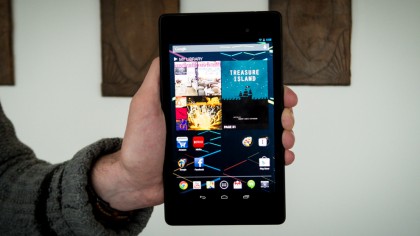Why you can trust TechRadar
Tesco Hudl 2

Tesco managed to hit budget tablet gold with its first Hudl device, and its second attempt has proved to be just as impressive. If the iPad mini still is a bit too pricey for your budget, then the Hudl 2 is a very compelling alternative.
It comes with an 8.3-inch screen compared to the iPad mini's 7.9-inch display, and both screens use IPS LCD technology for impressive viewing angles.
Resolution wise, the Hudl 2 is the winner, with a 1200 x 1920 resolution and a pixel density of 273, a fair bit more impressive than the iPad mini's 768 x 1024 resolution and 162 pixels per inch. For clarity and sharpness, the Hudl 2 is the one to go for here.
Where the iPad mini has a clear lead is with the aesthetics and build – as Apple's design department once again flexes its creative muscles. The iPad mini is a very slim and attractive tablet, and although the Tesco Hudl 2 isn't exactly ugly, there's no competition.
The performance of the Hudl 2 and iPad mini is both pretty close, although the Hudl suffers from some unnecessarily bloated apps that come preinstalled.
Google Nexus 7

Like the original iPad mini, the Nexus 7 is now also getting a bit long in the tooth, but if you're after a budget tablet then it still provides excellent value for money – especially as it can be had for around half the price of the iPad mini.
The Nexus 7's 7-inch screen means it's a slightly smaller device, and with the higher 1920 x 1200 resolution, you get a much clearer and sharp image on the Nexus 7. Text and images on the iPad mini don't look as nice, so if you want to do a lot of reading, then the Nexus 7 is the one to get.
Sign up for breaking news, reviews, opinion, top tech deals, and more.
The iPad mini still pips it in the looks department, but is it worth paying the extra cash? The Nexus 7 has also been updated from Android 4.3 Jelly Bean to Android 4.4 KitKat, and it's likely to get another boost at some point to Android 5.0 Lollipop, which is an excellent mobile operating system that can go toe to toe with the iPad mini's iOS.
iPad mini 3

The iPad mini has spawned two successors, so how does the elder device compare to its youngest sibling?
The iPad mini excels against its competition in the looks department, and it's obvious that when Apple was designing the third iteration it took a "if it ain't broke, don't fix it" mentality, as both iPad minis are almost identical.
Not just in looks, either, as both have the same 200 x 134.7mm dimensions, with the iPad mini 3 being ever so slightly thicker at 7.5mm (compared to 7.2mm of the older mini). The iPad mini 3 is also slightly heavier at 331g, compared to the original iPad mini's 308g.
Although both iPad minis have 7.9-inch displays, the iPad mini 3 boasts a huge upgrade with a 2048 x 1536 resolution, which grants the iPad mini 3's display a pixel density of 326ppi. This blows the 768 x 1024 resolution and 162ppi out of the water.
The iPad mini 3 also benefits from Touch ID, which allows you to unlock the device by pressing your finger on the home key. Since the launch of the iPad mini 3, the price of the iPad mini has dropped, but if you want a vastly improved screen and some exciting new features, then you'll want to splash out a bit more cash on the more recent iPad mini 3.

Gareth has been part of the consumer technology world in a career spanning three decades. He started life as a staff writer on the fledgling TechRadar, and has grew with the site (primarily as phones, tablets and wearables editor) until becoming Global Editor in Chief in 2018. Gareth has written over 4,000 articles for TechRadar, has contributed expert insight to a number of other publications, chaired panels on zeitgeist technologies, presented at the Gadget Show Live as well as representing the brand on TV and radio for multiple channels including Sky, BBC, ITV and Al-Jazeera. Passionate about fitness, he can bore anyone rigid about stress management, sleep tracking, heart rate variance as well as bemoaning something about the latest iPhone, Galaxy or OLED TV.
